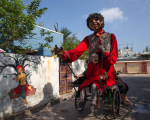The French East India Company (FEIC) were the last of the European powers to arrive in India. They first set up a factory in Surat (Gujarat), followed by Masulipatnam (Andhra coast). Their first colony was established at Chandernagore (Bengal). By end of the seventeenth century, they had gained a firm foothold in Pondicherry (now Puducherry), situated along the Coromandel Coast in Tamil Nadu. Governor-generals like Pierre Christophe Le Noir (r. 1726–34) and Pierre Benoît Dumas (r. 1734–41) expanded Pondicherry and added more territories—Yanam (1723) on the Andhra coast, Mahe (1725) on the Malabar coast, and Karaikal (1739), 140 kilometres south of Pondicherry. Together, these four geographically separate enclaves—plus Chandernagore—were administered from Pondicherry as Établissements français dans l'Inde (French settlements in India).
The FEIC reached its peak under Governor-General Joseph François Dupleix (r. 1742–54), who, in 1746, captured the British-held Fort St. George at Madras. After Dupleix left India in 1754, FEIC ambitions faltered. In 1757, with victory at Plassey, the British East India Company (BEIC) established itself as the preeminent European power in Bengal. In 1769, facing setbacks in their containment of the BEIC, and frustrated by lack of financial stability, the French Crown took direct control of all FEIC possessions. With the French threat neutralised, whenever war broke out in Europe between Britain and France, FEIC territories came under attack and occupation by the BEIC. The last time the British flag flew at Pondicherry was in 1816, when, with the conclusion of the Napoleonic Wars in mainland Europe, Pondicherry was reinstated as the capital of French India.
Soon after Indian Independence, in 1949, a referendum was held at Chandernagore, and it was ceded to India on May 2, 1950. Pondicherry and its enclaves were de facto handed over to India on November 1, 1954, and it was made a Union Territory. However, the de jure merger of Pondicherry with India happened on August 16, 1962, after the French parliament ratified the Treaty of Cession. This is why Pondicherry celebrates De Jure Da (Independence Day) on August 16, while the rest of India celebrates a day before, on August 15.
In the Treaty of Cession, the French and Indian governments agreed on preserving the unique French culture of Pondicherry by retaining some traditions. This included the continuation of French as the official language, and was taught in schools. Franco-Pondicherrians born and domiciled there before 1956 could retain French citizenship. Streets named after governor-generals and famous French personalities were to be continued to be used. Locals could observe the French calendar. And the French retained ownership of the French War Memorial, French Consulate, Institut français de Pondichéry (French Institute of Pondicherry), Lycée français international de Pondichéry (French International School of Pondicherry) and other institutions.
Though a speck on the map, Pondicherry is the capital of Francophone culture in India. I went to school at Pondicherry, where we were imparted French values, its rich culture and history, and the national motto of France: Liberté, égalité, fraternité (Liberty, Equality and Fraternity), which was born out of the Révolution française (French Revolution). Pondicherry’s historic ties with France are solemnly remembered and observed each year on Fête nationale (French National Day) on July 14, which commemorates the storming of the Bastille prison in Paris, in 1789, sparking the French Revolution. A day before, on July 13, pensioners in the Forces armées françaises (French armed forces) march to the Monuments aux Morts (French War Memorial), carrying the Indian and French flags and other battle standards. In the evening, La retraite aux flambeaux (the Torchlight Retreat) is held in the White Town, recreating the procession of lanterns carried by Parisian citizens during the French Revolution.
On Bastille Day, the French consul-general, various organisations of retired French civil and military personnel, consul-generals from other countries, and Franco-Pondicherrians, all pay homage to the Soldat Inconnu (Unknown Soldier). On this day, former soldiers proudly wear the medals they have received for service in various parts of the world. Facing the Bay of Bengal, Monuments aux Morts is a memorial to Franco-Pondicherrians who attained martyrdom in World War I. In total, 75 names are inscribed here. More plaques were added later, listing soldiers who died fighting in World War II, First Indochina War and Algerian War.
A few Franco-Pondicherrians refer to themselves as Creoles, a population mostly born to French and Tamil parents or their descendants. They now form only a small minority, mainly due to Indians from other parts of the country settling in Pondicherry in large numbers and emigration of Franco-Pondicherrains outside India. A sizeable Pondichérien diaspora now lives in France and former French colonies, significantly in Réunion and Seychelles in the Indian Ocean, the French West Indies islands of Martinique and Guadeloupe and French Guiana in South America. The Creole families living in Pondichery maintain camaraderie through their association Societie Mutuelle des Creoles (Mutual Society of Creoles) on Rue Bazard Saint Laurent.
French influence in Pondicherry is visible in the White Town, which represents French sentiment in its urban planning, streetscape and architecture. However, many dilapidated French-era buildings were demolished. Some heritage mansions were restored by INTACH (Indian National Trust for Art and Cultural Heritage) in collaboration with the government of Pondicherry. Some were converted to hotels, restaurants, cafes and boutique shops. In 2014, the Town Hall—constructed in 1870 to house the office of registrar of births and deaths and the municipal council—collapsed because of poor maintenance. Old Pondicherrians, including me, assembled to witness the demolition of this historic building, with tears in our eyes. It was at the Town Hall where many of my teachers and relatives got their marriage registered. Thankfully, the government reconstructed the Town Hall, recreating the traditional Indo-French architecture.
The French also had an impact on local food, which was extremely cosmopolitan, with influences from Tamil cuisine, Mughlai food and even used ingredients imported from French colonies in erstwhile Indo-China. Catholic Creoles have a very special way of cooking food, using plenty of spices, but is toned down to suit the French stomach. In recent years, French expatriates have opened restaurants in town, but none serve traditional Pondicherry Creole food. Motchamary Pushpam, Pushpa to the world, a Franco-Pondicherrian, started la table d’hôte ‘Chez Pushpa’.‘Creole food is slowly disappearing in our town,’ says Pushpa. At Chez Pushpa, guests can experience authentic Creole food, like Duck Vadavoum Kozhumbhu, Pok Vindaloo, Mutton Sambhar, Fish Assad Kozhumbhu, Keerai Poriyal with Prawns and Salad Creole, accompanied by some lovely conversations about history, culture and food with Pushpa and her family. It is through her and the efforts of other Franco-Pondicherrians that the unique culture of Pondicherry can be preserved for future generations.
This photo-essay has been created as part of the Sahapedia Frames Photography Grant, supported by CSR funding from IndusInd Bank.

















